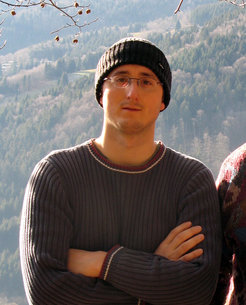Alumni 2011
Hsiang-Hsu Wang (19.1.) - Maximiliano Leonardo Moyano D'Angelo (19.1.) - Sofia Lianou (31.1.) - Min Fang (2.2.) - Anne Bochow (3.2.) - Isabel Franco Rico (4.2.) - Nikolay Nikolov (13.4.) - Leonard Burtscher (23.5.) - Sanjaya Paudel (1.6.) - Christine Ruhland (29.6.) - Christian Angrick (6.7.) - Ioanna Arka (18.7) - Ekaterina Lüttjohann (21.7.) - Rene Andrae (12.10.) - Bhargav Vaidya (26.10.) - Oliver Porth (9.11.) - Roman Follert (14.11.) - Mauricio Cisternas (15.11.) - Alexander Karim (23.11.) - Mario Gennaro (30.11.) - Carolina Bergfors (30.11.) - Gisella de Rosa (1.12.) - Christoph Deil (16.12.)
Gisella de Rosa (Italy) 01.12.2011

A comprehensive analysis of optical and near-infrared spectroscopy of z~6 quasars (thesis pdf, 5MB)
High redshift (z~6) quasars (QSOs) are unique probes of the early growth of accreting supermassive black holes (BHs) and are fundamental tools to study the ionization state of the intergalactic medium and its chemical enrichment. Until now, only the most luminous QSOs have been studied, often one object at the time. In this thesis we present the most extended consistent analysis to date of optical and near-infrared spectra of z~6 QSOs. Our NIR sample is composed of 22 spectra of QSOs at 4.5 An analysis of the wavelength shifts of the optical lines shows that the redshifts inferred from the OI+SiII complex, visible in most of the optical spectra, are consistent with those obtained from the MgII line. This implies that zOI is a reliable proxy for the QSO systemic redshift. We create a composite template of the z~6 QSOs that, red-ward the Ly-alpha line, remarkably resembles the one obtained for low-redshift QSOs. Investigating the existence of possible correlations amongst optical emission properties, we do not detect the expected anti-correlation between the EW and the QSO continuum luminosity (Baldwin effect) for the high ionization lines (NV & SiIV+OIV]). We show that a strong correlation holds between the line FWHM and its luminosity. Given the narrow distribution of Eddington ratios that characterizes the z~6 QSOs population, this implies that QSOs with brighter lines are the ones that host more massive BHs. We further confirm this statement by testing the relation between the line luminosity and MBH.
Finally we use our optical spectra to study the ionization state of the IGM at high redshift, by measuring the evolution of the near zone (NZ) sizes and that of the Gunn Peterson (GP) effective optical depth. Our comprehensive analysis shows that the correlation between the NZ radii and the QSO systemic redshifts is significantly reduced with respect to previous results. This implies that changes of the IGM ionization state are difficult to constrain through such measurements. We also outline a new method to detect the evolution of the GP effective optical depth through the analysis of the Ly-alpha and Ly-beta flux ratios. For each QSO we build a model based on the SDSS QSO composite spectrum and on the optical depth parametrization of lower-redshift absorbers (z<5.7). Comparing the QSOs flux ratios with the ones obtained from the models we detect a steep increase in the evolution of the effective optical depth.
Supervisors: Fabian Walter / Hans-Walter Rix (MPIA)
Christoph Deil (Germany) 16.12.2011

HESS and Fermi Surveys of the Galactic Gamma-ray Source Population (thesis pdf, 80MB)
The High Energy Stereoscopic System (HESS) is an array of four imaging atmospheric Cherenkov telecopes, located in Namibia, observing the gamma-ray sky at energies > 100 GeV since 2004. For the first time HESS has surveyed the Galactic plane (approximately in the range GLON = -110 to +70 deg, GLAT = -3 to 3 deg) and detected a number of sources, each one a cosmic particle accelerator emitting gamma rays produced in interactions of the cosmic rays with ambient matter and radiation fields. In this thesis the full HESS Galactic plane survey dataset was used to derive significance and flux maps as well as a catalog of 62 sources containing their position, extension and spectrum. Several new methods for an improved and semi-automatic detection and analysis of all sources were developed. The Fermi Large Area Telescope (LAT) is a space-based gamma-ray telescope, continuously performing an all-sky survey above 100 MeV since June 2008. Based on two years of data in the energy range 100 MeV to 100 GeV the LAT collaboration has published a catalog of 1873 sources, 244 of which, mostly of Galactic origin, are located inside the HESS survey region. In this work allsky significance and flux maps and catalogs of 74 Fermi sources above 10 GeV and 42 sources above 100 GeV are derived and a preliminary comparison with the HESS data is presented. This work can serve as the basis for future detailed studies of the Galactic gamma-ray source population.
Supervisor: Werner Hofmann (MPIK)
Carolina Bergfors (Sweden) 30.11.2011

Formation of stars, substellar objects and exoplanets : Observations of multiplicity (thesis pdf, 2MB)
Many nearby stars are part of a binary or multiple system. Details about their history are preserved in their multiplicity characteristics, and observations of binary/multiple star systems provide a way to measure fundamental physical properties of the stars as well as clues to their formation and evolution. Moreover, planet formation and dynamics may also be affected by the presence of a second star, or by giant planets in the same system.
In this thesis, high resolution imaging of low-mass stars, planet host stars and a multiple planet system is presented. The results of observations and analyses include the discovery of several previously unknown companion stars and multiplicity statistics for M dwarfs in the largest M dwarf multiplicity survey to date. We also present near-infrared characterization of four close M dwarf systems, previously unknown companion candidates to exoplanet host stars, and investigate how a close companion may affect planet formation. New astrometric data is presented for three of the directly imaged planets in the HR8799 system, and an analysis of a possible orbital configuration of planet HR 8799 d.
Supervisors: Wolfgang Brandner / Thomas Henning (MPIA)
Mario Gennaro (Italy) 30.11.2011

Massive clusters revealed in the near infrared : Constraining the early stages of stellar evolution (thesis pdf, 25MB)
Stellar clusters can be considered as the building blocks of galaxies. Studying how clusters form and evolve is crucial in understanding the evolution of their host galaxies. Young massive stellar clusters, in particular, play a key role in placing constraints on the physics of star formation and evolution. The stellar population inside these extremely massive objects spans the full range of stellar masses from very low mass brown dwarfs to the most massive stellar objects currently known. One of the most important tools to study stellar clusters are stellar evolutionary models, i.e. tracks and isochrones from which masses and ages can be derived. Resolved stellar populations in clusters can in turn be used to test and calibrate these theoretical models.
In this work I first present a study of the current generation of pre-main sequence models and their thorough use for assessing stellar properties. I then continue using stellar models to study the most massive young cluster in the Milky Way: Westerlund 1. The last part of this work deals with the first multiple wavelength investigation of a recently discovered star forming region: the CN15/16/17 complex. This region was observed in the framework of an extended cluster search. I used near infrared observations to look for the missing cluster that are yet to be found in our Galaxy in order to unveil the mysteries of star formation in the inner parts of the Milky Way.
Supervisors: Wolfgang Brandner / Thomas Henning (MPIA)
Alexander Karim (Germany) 23.11.2011

Star Formation in the COSMOS Field : A radio view on the build-up of stellar mass over 12 billion years (thesis pdf, 15MB)
In this thesis I study the evolution of galaxies with a special focus on their star forming ability by using the extensive multi-wavelength data sets available for the 2 square degree COSMOS deep field. The deep radio continuum data from Very Large Array observations at a frequency of 1.4 GHz (a wavelength of 20 cm) form the basis of my analysis of the cosmic star formation history unaffected by dust obscuration.
A newly developed stacking algorithm enabled an unprecedentedly representative view on the evolution of the average star formation rate within galaxies down to low limiting (stellar) masses since a redshift of z~3 (i.e. ~2 billion years after the Big Bang). My findings are in good agreement with results from different star formation diagnostics that often suffer from large dust corrections or significantly worse statistics. A main result of this thesis is the identification of a constant characteristic mass for star forming galaxies. It implies that galaxies with masses similar to our Milky Way have always been the main sites of star formation. Therefore the often debated 'downsizing scenario' where the characteristic mass decreases with cosmic time is ruled out. In the young universe (<1.5 billion years of cosmic age) I successfully searched for the most extreme star forming environments. These provide critical constraints on cosmic structure formation and dust enshrouded star formation at early times. A detailed case study not only reveals large amounts of molecular gas but also a powerful hidden active galactic nucleus in one such massive starburst. This finding demonstrates the diversity of this cosmologically important galaxy population.
Supervisors: Eva Schinnerer / Hans-Walter Rix (MPIA)
Mauricio Cisternas (Chile) 15.11.2011

Galaxies and supermassive black holes evolving in a secular universe (thesis pdf, 2MB)
Most massive galaxies host a supermassive black hole (BH), that had most of its mass built up throughout bright periods of vigorous accretion, during which it is referred to as an active galactic nucleus (AGN). In the local universe it has been observed that BH mass (M_BH) follows tight correlations with various properties of the galactic bulge in which it resides. This led to the currently popular ``co-evolution'' picture, in which most present-day galaxies went through at least one active phase in the past, during which a link between galaxy and BH gets established. However, more robust observational constraints are required on how galaxy and BH related at earlier times, and which mechanism is responsible for triggering these BH growth phases. This thesis studies a large sample of AGN out to z~1 from the COSMOS survey, selected from their X-ray emission and imaged in finest detail with the Hubble Space Telescope, allowing the study of growing BHs together with their host galaxies. We present new constraints on the ratio of BH mass to $total$ galaxy stellar mass (M_*) over the last 7 Gyr for 32 type-1 AGN. We show that the M_BH-M_* ratio at z~0.7 is consistent with the local relation between BH mass and galactic bulge mass. For these galaxies to obey the local relation only a redistribution of disk-to-bulge mass is needed, likely driven by passive secular evolution.
We then tackle and answer a 30-year old question: what is the relevance of major mergers and interactions as triggering mechanisms for AGN activity? We visually analyze the morphologies of 140 AGN out to z~1 looking for signatures of recent mergers, and compare them with a control sample of over 1200 matched inactive galaxies. We find that the merger fraction of the AGN host galaxies is statistically identical to the corresponding inactive galaxy population, at roughly 15%. Together with the fact that the majority of the AGN host galaxies are disk-dominated, unlikely relics of a recent major merger, these results are the strongest evidence to date that secular evolution rather than major merging has dominated BH fueling at least since z~1, and that BHs and galaxies have, for the last 7 Gyr, evolved in a secular universe.
Supervisors: Knud Jahnke (MPIA)
Roman Follert (Germany) 14.11.2011

The atmospheric piston simulator for LINC-NIRVANA and Interferometric observations of massive young stellar objects (thesis pdf, 15MB)
The scope of this dissertation is two - fold. The first part describes the design, construction and verification of the atmospheric piston simulator. The atmospheric piston simulator is a device which will allow the verification of the LINC-NIRVANA fringe tracking system under as realistic as possible conditions. The design of the atmospheric fringe tracker is based on optical fibers for light guiding and integrated optics components for the manipulation of the phase of the transmitted light. This fiber based setup allows on the one hand an easy an reliable way to introduce differential piston sequences, on the other hand integration into LINC-NIRVANA will be trivial. The second part of this dissertation describes the application of Interferometry in the case of the observation of massive young stellar objects. Two objects are presented and discussed in detail: the Kleinmann & Wright object and AFGL 2136. The interferometric measurements as well as the data reduction are described. The spectrally dispersed visibility curves and the differential phase data are fitted by analytical geometrical models. Then, the interferometric data and results from a spectral energy distribution analysis are combined and compared to Monte-Carlo radiative transfer simulations. The results of this analysis indicate the existence of circumstellar disks similar to those found in low mass star formation. A detailed analysis of the mid-infrared silicate absorption features also indicates significant dust grain evolution in AFGL 2136.
Supervisors: Tom Herbst / Hans-Walter Rix (MPIA)
Oliver Porth (Germany) 09.11.2011

Formation of Relativistic Jets : Magnetohydrodynamics and Synchrotron Radiation (thesis pdf, 20MB)
In this thesis, the formation of relativistic jets is investigated by means of special relativistic magnetohydrodynamic simulations and synchrotron radiative transfer. Our results show that the magnetohydrodynamic jet self-collimation paradigm can also be applied to the relativistic case. In the first part, jets launched from rotating hot accretion disk coronae are explored, leading to well collimated, but only mildly relativistic flows. Beyond the light-cylinder, the electric charge separation force balances the classical trans-field Lorentz force almost entirely, resulting in a decreased efficiency of acceleration and collimation in comparison to non-relativistic disk winds. In the second part, we examine Poynting dominated flows of various electric current distributions. By following the outflow for over 3000 Schwarzschild radii, highly relativistic jets of Lorentz factor 8 and half-opening angles below 1 degree are obtained, providing dynamical models for the parsec scale jets of active galactic nuclei. Applying the magnetohydrodynamic structure of the quasi-stationary simulation models, we solve the relativistically beamed synchrotron radiation transport. This yields synthetic radiation maps and polarization patterns that can be used to confront high resolution radio and (sub-) mm observations of nearby active galactic nuclei. Relativistic motion together with the helical magnetic fields of the jet formation site imprint a clear signature on the observed polarization and Faraday rotation. In particular, asymmetries in the polarization direction across the jet can disclose the handedness of the magnetic helix and thus the spin direction of the central engine. Finally, we show first results from fully three-dimensional, high resolution adaptive mesh refinement simulations of jet formation from a rotating magnetosphere and examine the jet stability. Relativistic field-line rotation leads to an electric charge separation force that opposes the magnetic Lorentz force, such that we obtain an increased stability of relativistic flows. Accordingly, the non-axisymmetric modes applied to the field-line foot-points saturate quickly, with no signs of enhanced dissipation or disruption near the jet launching site.
Supervisor: Christian Fendt (MPIA)
Bhargav Vaidya (India) 26.10.2011

Theory of disks and outflows around massive young stellar objects (thesis pdf, 19MB)
The inner most regions around massive young stellar objects (YSO) are associated with complex interactions between numerous physical processes. Since the inner few Astronomical Units (AU) are tough to resolve observationally, a theoretical approach is important to create a qualitative picture for these regions around young high-mass stars. This thesis investigates the interplay between important physical processes with respect to the dynamics of jets and inner accretion disks. This thesis provides a bridge between the physical structures of the inner and the outer disk, where the later is observationally easier to access. Above all, the importance of the radiative force in altering the dynamics of a magnetically launched jet is outlined in this thesis.
A thin accretion disk model with proper gas and dust opacities is applied for a luminous young high-mass star. This study has furnished estimates of various physical quantities in the inner few AU of the accretion disk. In particular, I have found that the mid-plane temperature around 0.1 AU could be as high as 10^5 K for a 10 Msun star. Such high temperatures in the disk destroy most of the dust grains already at large radii from the central star. This in turn reduces the opacity of the accreted matter thereby overcoming the central radiation-pressure from the young massive star. In addition, such disks are stable to gravitational fragmentation inside of 100 AU from the central star. Thus they form an ideal launching base for long-lasting outflows.
Outflows and jets are an ubiquitous phenomenon in young massive star forming regions. Observational surveys have suggested that the outflows become wider as the star grows in luminosity (thus mass) with time. I have performed magneto-hydrodynamical simulations of jet launching in presence of radiative forces from the luminous star and the inner hot accretion disk. The major outcome of this work, is that the radiative force from the central star plays a dominating role in accelerating and de-collimating the magnetically launched jet, while the influence of the disk radiative force is rather small. In addition, conducting an extensive parameter study, I have found that the outflows become wider as the mass (or luminosity) of the central star increases. The degree of collimation is also affected by the magnetic field strength and optical thickness of the line. This interplay of radiative and magnetic forces provides a physical insight to the trend in degree of collimation suggested by observations.
Finally, a fully three-dimensional simulation is conducted to understand the manner in which the inner accretion disk transports material onto the central massive star. The hydrodynamic flow in the disk is simulated in the presence of radiative transfer and/or self-gravity. The transport of angular momentum is solely due to gravitational torques. My first results indicate that a locally isothermal disk becomes gravitationally instable and fragments in the inner parts as it is fed with matter from the outer massive core with a steady accretion of 10^-3 Msun yr^-1. About 10% of the mass added onto the disk is accreted onto the central star in form of clumps. On the other hand, no fragmentation is seen in an adiabatic disk whose initial temperature profile is consistently derived from radiative transfer calculations. This investigation complements the above semi-analytical study of the inner disk to single out the physics of angular momentum transport in massive accretion disks.
Supervisors: Christian Fendt / Henrik Beuther (MPIA)
Rene Andrae (Germany) 12.10.2011

Alignment of disc galaxies : Testing the theory of angular-momentum acquisition (thesis pdf, 7MB)
This thesis is concerned with the formation of disc galaxies, a special type of galaxies characterised by ordered rotation. The main focus is on testing predictions of theories that try to explain the angular-momentum acquisition of these galaxies. A major issue concerns the proper quantification of galaxy morphologies. This is of vital importance for automated and reproducible classification of disc galaxies in large data samples. The most promising approach is to expand galaxy morphologies into orthonormal basis functions based on a well motived light profile (the Sersic profifile). In the main part of this thesis, the angular momenta of several thousand disc galaxies from the Sloan Digital Sky Survey are analysed. It is demonstrated that previous investigations lacked a rigorous account for the relevant error sources, which lead to unjustified confirmations of theoretical predictions. If all relevant errors are considered, there is no statistical evidence confirming these predictions. The methods developed here are also relevant in a wider context, as they are applicable to other astrophysical investigations. This thesis concludes with a detailed discussion of potential improvements of measurements and an outline of an observational strategy that will allow for a more decisive empirical test of the theoretical predictions.
Supervisors: Knud Jahnke (MPIA)
Ekaterina Lüttjohann (Russia) 21.07.2011

Chemische und mineralogische Entwicklung Protoplanetarer Scheiben (thesis pdf, 4MB)
Modern measurement techniques provide a lot of information about the chemical composition of comets and protoplanetary disks. Studies of the istotopic composition of meteorites provide further information about the conditions of formation for these compounds. However, the history of formation and the evolution paths of these species are often not known.
This work shows that the oldest compounds of the solar system, the calcium aluminum rich inclusions (CAIs) may form during the collaps of a molecular cloud. After the formation they are transported to distances several ten AU away from the region of their formation.
Furthermore, the destruction mechanisms of presolar SiC particles are studied in this work. The calculations show that the ratio between presolar SiC grains and presolar carbon grains in meteorites cannot be explained solely by oxidation processes in the solar nebula.
Another chapter of this work describes the chemical evolution of hydrocarbons in protoplanetary disks. The gas phase chemistry is calculated using methods of chemical kinetics. For this purpose 45 species and 220 reactions are included in the calculation. It is shown that the destruction of carbon grains leads to the formation of hydrocarbons in the inner parts of protoplanetary disks.
Supervisor: Hans-Peter Gail (ITA)
Christine Ruhland (Germany) 29.06.2011

Signposts of Hierarchical Merging (thesis pdf, 22MB)
In a Lambda-CDM universe, the merging of galaxies plays a key role in their formation and evolution. In this thesis I focus on two aspects of this picture.
The first one is the accretion of satellite galaxies onto disk galaxies, specifically the Milky Way, leaving the galaxy mostly undisturbed in its morphology, but contributing to the stellar populations of its faintest, but most extended component, the stellar halo. I have developed techniques for detecting and exploring stellar streams formed through the tidal disruption of satellites. The main results are the discovery of a candidate stellar stream, and detailed characterization of the Sagittarius tidal stream, a key probe of the Milky Way potential.
In the other project, I explore the evolution of early-type galaxies—thought to be the result of merging of disk galaxies. I show that the observed evolution of their color-magnitude relation (a probe of their stellar populations) is consistent with a constant addition of galaxies with recently truncated star formation. On both scales these studies are consistent with the notion that merging has played an important role in shaping the galaxies as we see them in the present day universe and continues to do so.
Supervisors: Eric Bell / Hans-Walter Rix (MPIA)
Ioanna Arka (Greece) 18.07.2011

Non-linear waves in the laboratory and in astrophysics: Pair production in counter-propagating laser beams and strong waves in pulsar winds (thesis pdf, 5MB)
In this work we are investigating non-linear electromagnetic waves in two different physical environments: laboratories on earth and the astrophysical objects known as pulsars. In the first part of our work the interaction of electrons and positrons with strong waves in the form of high intensity laser beams is analyzed. The possibility of emission of energetic radiation which can result in prolific pair production in the focus of two short, counter-propagating ultrahigh intensity laser pulses is examined, taking into account several different possibilities for the relative polarizations and the waveform of the beams. The conclusion is reached that in the next generation laser facilities currently under construction mainly in Europe, like ELI and the 10PW Vulcan laser, pair production and electromagnetic pair cascades should be observed for intensities as low as 1024Wcm−2.
In the second part of this work we focus on large amplitude, low frequency waves that are emitted by pulsars. After a brief review of the current understanding of pulsar winds and the problems inherent to it, we show that the interaction of a relativistic striped pulsar wind with the the termination shock should result in reflection of electromagnetic energy in the upstream, which can affect the outflow, creating a precursor. We then investigate the possible conversion of the pulsar wind to a superluminal linearly polarized wave propagating upstream of the termination shock and show that this will result in the transfer of energy from the fields to the outflow particles in the precursor, lowering the magnetization of the outflow and opening the way for further particle acceleration at the shock front.
Supervisor: John Kirk (MPIK)
Leonard Burtscher (Austria) 23.05.2011

Mid-infrared interferometry of AGN cores (thesis pdf, 27MB)
Active Galactic Nuclei (AGNs) are among the most luminous objects in the universe and are classified into a number of types and subtypes. Unified models of AGNs explain some of this variety as a result of different viewing angles towards their cores instead of intrinsic differences: from some viewing angles, our line of sight would be blocked by a dusty torus.
The spatial resolution necessary to resolve these warm dust structures at 10 micron is currently only provided by the Very Large Telescope Interferometer (VLTI) in Chile. First, extensive observations of the radio galaxy Centaurus A are examined that show an extended structure, which is probably connected to the Northern nuclear radio jet, at a distance of about 40 milli arcseconds (0.7 parsec) in front of the nucleus. Secondly, a study of the brightest so-called type 1 Seyfert galaxy, NGC 4151, reveals for the first time a resolved nuclear emitter in such a source. Its properties (size, temperature profile, emissivity) are similar to those of the alternative type 2 galaxies, studied previ- ously. This is consistent with, though not necessarily confirmation of, unified models. Since the previous studies of type 2 source and modern torus models show a wide variety of nuclear dust structures, finally, the so-far most comprehensive study of resolved nuclear dust emission of AGNs is set up to study 13 AGNs of various luminosities L and distances reaching several hundred Mega Parsec. The first full analysis of this study shows in all but one galaxy that tori can be resolved and that their size on parsec scales is not simply proportional to L^0.5.
Supervisor: Klaus Meisenheimer (MPIA)
Christian Angrick (Germany) 06.07.2011

On the derivation of an X-ray temperature function without reference to mass and the prediction of weak-lensing number counts from the statistics of Gaussian random fields (thesis pdf, 5MB)
We present a novel approach for the derivation of the X-ray temperature function for galaxy clusters, which is based on the statistics of Gaussian random fields applied to the cosmic gravitational potential. It invokes only locally defined quantities so that no reference to the cluster's mass is made. To relate linear and non-linear potential and to take into account only structures that have collapsed, we include either spherical- or ellipsoidal-collapse dynamics and compare both resulting models to temperature functions derived from a numerical simulation. Since deviations from the theoretical prediction are found in the simulation for high redshifts, we develop an analytic model to include the effects of mergers in our formalism. We jointly determine the cosmological parameters Omega_m0 and sigma_8 from two different cluster samples for different temperature definitions and find good agreement with constraints from WMAP5. Introducing theoretically a refined detection definition based on the upcrossing criterion, we reformulate our analytic approach for 2D and use it to predict the number density of spurious detections caused by large-scale structure and shot noise in filtered weak-lensing convergence maps. Agreement with a numerical simulation is found at the expected level.
Supervisor: Matthias Bartelmann (ITA)
Sanjaya Paudel (Nepal) 01.06.2011

Early-type dwarf galaxies: Insight from stellar population studies (thesis pdf, 10MB)
We have studied the stellar population properties of a sample of early-type dwarf galaxies (dEs) in Virgo cluster. We derived the simple stellar population (SSP) parameters age and metallicity using the method of Lick indices. We found that not all dEs exhibit the same stellar population properties. The dEs with disc features are relatively younger and more metal enhanced than dEs without disc. We also found the nuclei of dEs have smaller ages and higher metal content than the respective galactic main bodies. Comparing the SSP parameters at the same local density, where the Ultra Compact Dwarf galaxies (UCDs) are located, we do not find any diㄦence in the stellar population properties of dEs nuclei and UCDs. We confirmed that the metallicity correlate with the galaxies luminosity in all classes of earlytype galaxies i.e. Es, dEs and dSphs and dEs luminosity-metallicity relation has the steepest slope among all classes. We discovered a clear break in this relation in the dEs region. The bright and metal rich dEs seem to follow a faint end extension of Es and the metal poor and old dEs either hold a genuine class of early-type dwarf galaxies or just a bright end extension of dSph.
Supervisor: Thorsten Lisker (ARI)
Anne Bochow (Germany) 03.02.2011

A systematic study of Supernova Remnants as seen with H.E.S.S. (thesis pdf, 2MB)
Supernova remnants (SNRs) are the remainders of extremely energetic explosions occurring at the end of a star's life. With the energy released during the supernova explosion they are believed to accelerate charged particles to energies of up to 10^15 eV. In the very-high-energy (VHE, > 10^11 eV) gamma-ray band, SNRs represent one of the most populous classes of Galactic sources. Due to its unprecedented sensitivity, H.E.S.S. was the first instrument to allow for a morphological resolution of individual SNRs, proving the existence of particle acceleration and subsequent VHE gamma-ray emission. However, to date many more SNRs are known in the radio waveband than in VHE gamma-rays. This work presents a systematic study of the VHE gamma-ray signal of a sample of around 200 radio SNRs. The VHE gamma-ray-signal of these SNRs is studied individually. Besides the spatial correlation of radio SNRs and VHE gamma-ray sources, the measured flux of VHE gamma-rays is compared to theoretical flux predictions. These predictions are based on assumptions of the total explosion energy, the particle acceleration effciency, the density of the surrounding medium and the distance of the SNRs. The results presented here suggest that these parameters can vary strongly for individual SNRs. Future observations of SNRs in VHE gamma-rays and other wavebands will help to constrain the parameter space and will allow to further discuss acceleration mechanisms in SNRs.
Supervisor: Werner Hofmann (MPIK)
Nikolay Nikolov (Bulgaria) 13.04.2011

A Photometric Study of Transiting Extrasolar Planets (thesis pdf, 50MB)
In this thesis I present observational methods to detect and characterize transiting extrasolar planets. I study the most common types of astrophysical false positives, identified by ground based photometric transit surveys. I implement and test three robust methods for the Pan-Planets pipeline to classify false alarms, based on the transit light curve morphology: evaluation of out-of-eclipse ellipsoidal variability; determination of astrophysical parameters from a transit fit; and exoplanet diagnostic (eta).
I obtain results from systematic tests of the pipeline using data from OGLE, Pan-Planets simulations and confirmed transiting exoplanets. I confirm the first method as most reliable in ruling out transit-like events due to stellar binaries. I further, present results from a photometric analysis of data obtained with LAIWO at the 1-m telescope at Wise Observatory. I study the necessary methods to obtain high quality light curves at the millimagnitude level down to R = 16 mag. I perform a search for periodic transit events (1 - 2%) and variable stars and identify 22 transit candidates as well as 20 periodic variables. An analysis of the photometric colors, ellipsoidal variability and the exoplanet diagnostic suggests that between zero and two of the light curves should be produced by exoplanets. Furthermore, I propose a follow-up scheme for their confirmation.
Finally, I obtain high signal-to-noise ratio simultaneous multi-band optical/NIR photometry of WASP-4, during three transits of its exoplanet, with the GROND instrument at the ESO/MPG 2.2-m telescope at La Silla Observatory. I produce and analyze its light curves and measure the planet radius, orbital period, semimajor axis and inclination in conjunction with a study of the transit mid-times. An analysis of WASP-4b transit ephemeris, derived from the results, confirms the lack of transit timing variations (TTVs).
Supervisors: Cristina Afonso / Thomas Henning (MPIA)
Sofia Lianou (Greece) 31.01.2011
The interacting M81 group of galaxies (thesis pdf, 20MB)
The topic of this Thesis is the role of the environment and interactions on the formation and evolution of dwarf galaxies in nearby groups. The M81 group is a highly interacting group, offering a unique opportunity to study the impact of the environment on shaping the properties of its dwarf galaxy population. We use the Tully-Fisher relation to search for potential tidal dwarf galaxies in the M81 group. No potential tidal dwarfs were identified. Furthermore, we derive photometric metallicity distribution functions and examine the presence of metallicity gradients for nine early-type dwarf galaxies of the M81 group. The comparison of their mean metallicity properties with those of Local Group dwarfs shows that these are similar. Not all of the dwarfs show a metallicity gradient, as is also the case of Local Group dwarfs. The fraction of luminous asymptotic giant branch stars in each dwarf is small, while their fraction as a function of their distance from the M81 galaxy does not show any trend. The results indicate that the studied properties are affected by internal processes. Finally, the method of deriving photometric metallicities is evaluated for dwarf galaxies with complex star formation histories, using Galactic dwarf spheroidals. The resulting mean photometric metallicity properties are in good agreement with spectroscopic measurements, while individual star differences become larger the more complex the star formation is.
Supervisor: Eva Grebel (ARI)
Isabel Franco Rico (Mexico) 04.02.2011

The origin of low-mass early-type galaxies: A combined view from stellar populations and N-body simulations (thesis pdf, 3MB)
The COMBO-17 survey data is used to measure stellar masses of late and early-type galaxies in the redshift range 0 < z < 2.1. Hierachical galaxy formation predicts that early-type galaxies leave the blue cloud and assemble at z~1. The transit from blue cloud to red sequence is yet not fully understood. We explore one formation mechanism that might explain how late-type galaxies can transform in low-mass early type galaxies via galaxy harassment. We aim to understand the formation of early-type dwarf galaxies through the so-called galaxy harassment scenario. We perform N-body simulations in which a three-component galaxy (disk + bulge + halo) enters a galaxy cluster in an eccentric orbit. While the galaxy is falling, it gets tidally disrupted by close encounters with other galaxies that populate the cluster. Such encounters are sufficiently vigorous to morphologically transform the galaxy into an early-type dwarf. Through a combined N-body and stellar population approach, we assign multiple stellar generations to the simulated galaxy and trace their evolution. This allows us to extract observable quantities, in particular integrated colours, in order to compare the simulation results to observed Virgo cluster early-type dwarfs. Based on this analysis we discuss whether harassment is able to form typical early-type dwarf galaxies.
Supervisor: Thorsten Lisker (ARI)
Maximiliano Leonardo Moyano D'Angelo (Chile) 19.01.2011

A search for transiting extrasolar planets with the LAIWO instrument (thesis pdf, 20MB)
In this thesis we study the necessary methods to perform a transit search for extrasolar planets. We apply these methods to search for planets in one of the fields of the LAIWO project: the Cygnus-Lyra field (Laiwo VI). We describe the problems that systematic effects can introduce for precise relative photometry at the millimagnitude level (~3mmag). Ways to minimize and quantify this correlated noise are also described. We test the weaknesses and strenghts of two transit detection algorithms (TDA) namely the Box fitting algorithm (BLS) and the TRUFAS algorithm using archive data from the OGLE project and simulations of the first year of the Pan-Planets survey. These projects are similar in terms of telescope size and field of view to the LAIWO survey. We have found that the main limitations of the BLS algorithm are the transit depth and correlated noise (Red Noise). The TRUFAS detection efficiency correlates with the number of points in transit and the number of transits present in the light curve, and, its detection efficiency is low (less than ~ 50%) for these type of ground-based observations. Finally, we create from the LAIWO data light curves which are suitable to detect planets among the stars brighter than R = 16.5 mag. We have found 31 eclipsing binaries and 18 light curves that have transits consistent with a planet. Of these detections, 3 eclipsing binaries and 8 planet candidates were independently found by the KEPLER survey. Of the 10 newly discovered transiting planets, 3 are promising to justify follow-up confirmation studies, which are always necessary to probe the planetary nature of a transiting companion.
Supervisor: Thomas Henning (MPIA)
Hsiang-Hsu Wang (Taiwan) 19.01.2011

Gas evolution in disk galaxies: disk stability, gas accretion & the impacts of spiral density waves (thesis pdf, 4MB)
This thesis studies many aspects of gas evolution in disk galaxies. A simple, effective method is developed for initializing a three-dimensional gaseous disk which is in detailed equilibrium. With this method, theoretical predictions for disk stability and swing amplification are numerically studied for three-dimensional disks. The missing link between intergalactic gas accretion and the star formation activity is found for the galaxy M83. We improve the analysis method to search for the signature of gas infall. For the first time, gas accretion with sufficient fresh gas to fuel star forming disk is kinematically confirmed. The impacts of spiral density waves on gas motions are studied numerically. Shock driven turbulence is quantified and is found to match excellently with observations. Furthermore, the evolution of shock itself has profound impacts on redistributing gaseous surface density, angular momentum and on the development of substructures.
Supervisors: Ralf Klessen (ITA), Kees Dullemond (MPIA)
Min Fang (China) 02.02.2011

The disks and accretion behavior of Young Stellar Objects (thesis pdf, 10MB)
Circumstellar disks play an essential role in the star formation process and are thought to be the sites where new planetary systems come into being. Knowledge of the evolution of these objects is pivotal to our understanding of star and planet formation. In this thesis, I present three studies aimed at characterizing the properties of newly formed stars and their circumstellar accretion disks in three qualitatively different environments: the sparse stellar association epsilon Cha, the L1630 and L1641 regions of clustered and distributed star formation in Orion, and the massive cluster Pismis 24. I combined infrared observations, taken from the ground and with the Spitzer Space Telescope, with optical imaging and spectroscopy obtained with various ground-based facilities. I characterized the disk geometry and evolutionary state using the infrared data, and from the optical data I determined the stellar properties as well as the rate at which disk material is accreted onto the central stars. Two important insights gained through my studies are: (1) the disk lifetimes for stars formed in isolation or sparse stellar associations are longer than those of stars formed in relatively dense clusters, whereas the disk lifetimes in clusters harboring very massive stars with spectral types earlier than ~O5 are shorter than those in otherwise similar clusters that lack such very massive stars; (2) the accretion rates show a steeper dependence on the stellar mass in the sub-solar mass regime than in the solar or intermediate mass regime.
Supervisors: Roy van Boekel, Thomas Henning (MPIA)





















